2023届高考英语语法点梳理:助动词和情态动词 课件(15张PPT)-
文档属性
| 名称 | 2023届高考英语语法点梳理:助动词和情态动词 课件(15张PPT)- | 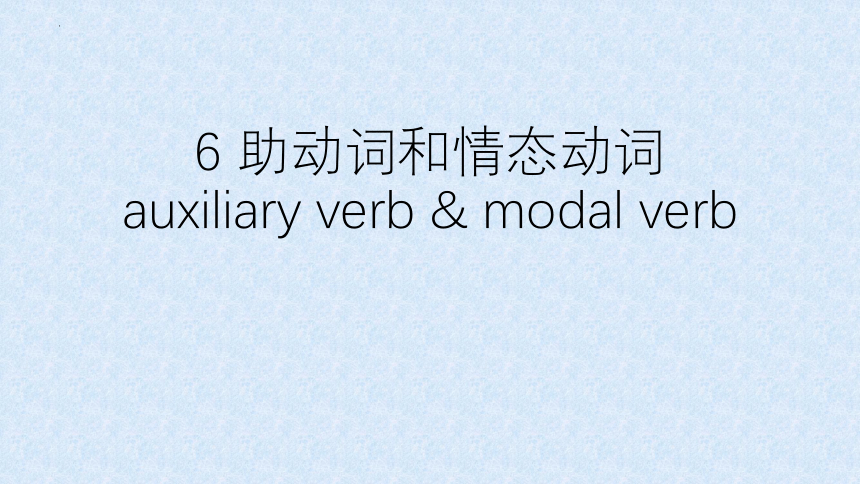 | |
| 格式 | zip | ||
| 文件大小 | 108.1KB | ||
| 资源类型 | 教案 | ||
| 版本资源 | 通用版 | ||
| 科目 | 英语 | ||
| 更新时间 | 2022-07-27 17:58:47 | ||
图片预览

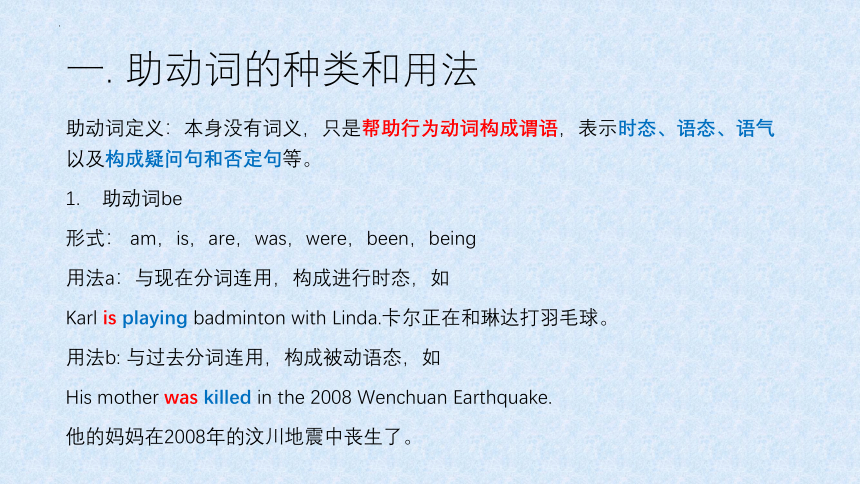


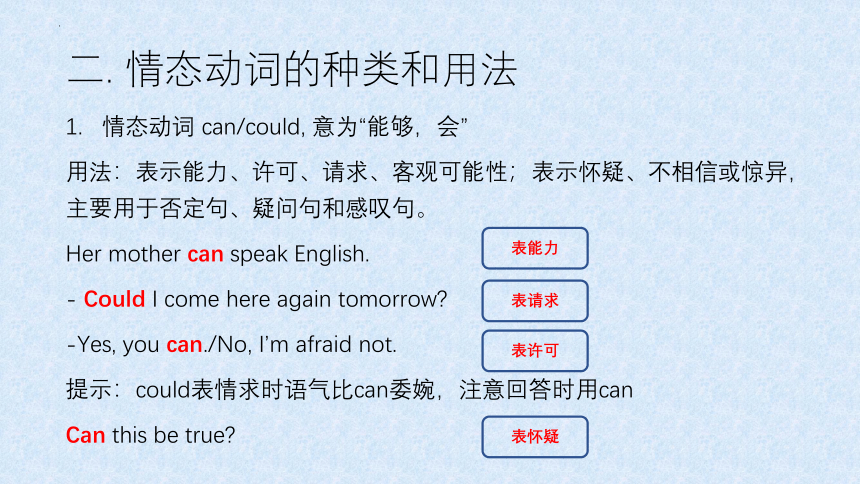
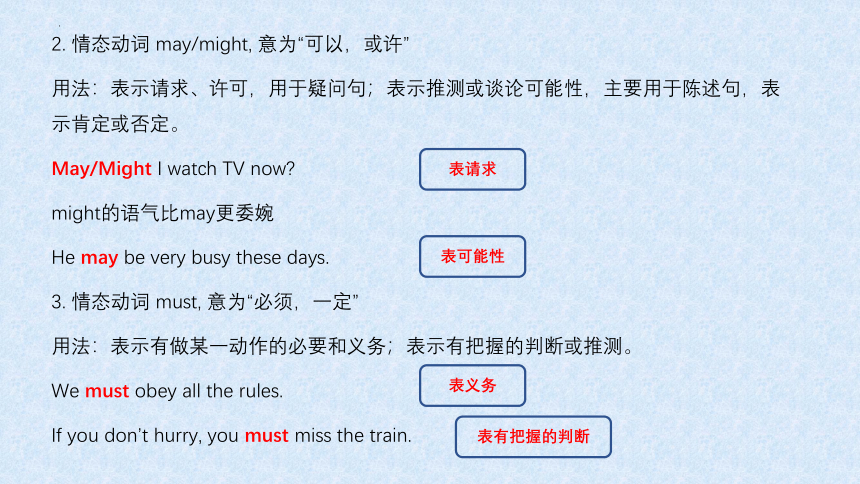
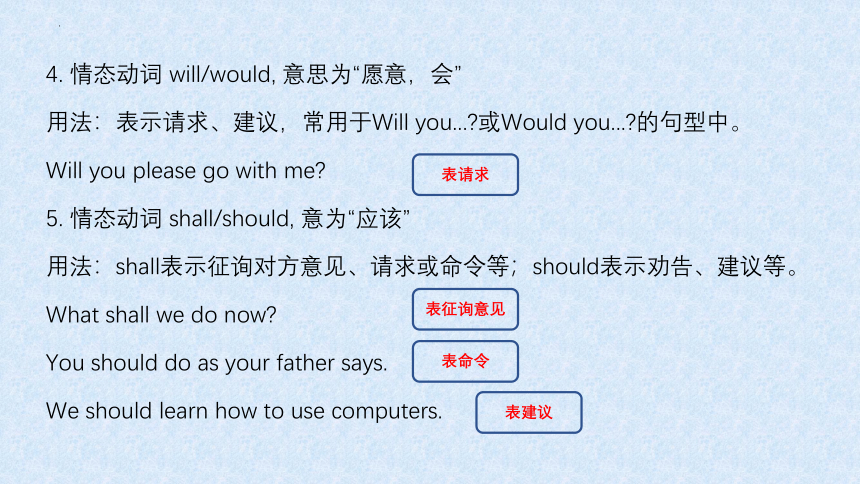
文档简介
(共14张PPT)
6 助动词和情态动词
auxiliary verb & modal verb
一. 助动词的种类和用法
助动词定义:本身没有词义,只是帮助行为动词构成谓语,表示时态、语态、语气以及构成疑问句和否定句等。
助动词be
形式: am,is,are,was,were,been,being
用法a:与现在分词连用,构成进行时态,如
Karl is playing badminton with Linda.卡尔正在和琳达打羽毛球。
用法b: 与过去分词连用,构成被动语态,如
His mother was killed in the 2008 Wenchuan Earthquake.
他的妈妈在2008年的汶川地震中丧生了。
2. 助动词have
形式:have, has, had, having
用法:与过去分词连用,构成完成时态,如
Ketty has seen the Backstreets Boys in a concert in Beijing.
凯蒂已经在北京的一场音乐会上见到后街男孩了。
3. 助动词shall (should), will (would)
用法:与动词连用,构成将来时态,如
We shall be very happy to see you. 我们见到你会很高兴的。
I will make Charlie a chocolate cake tomorrow.
我明天将为查理制作一块巧克力蛋糕。
4. 助动词do
形式:do, does, did
用法:与其他动词连用,构成否定句或疑问句,如
I don’t like having a barbecue in hot weather.
我不喜欢在炎热的天气吃烤肉。
Does your uncle keep pets 你叔叔养宠物吗?
提示:助动词do也可用在动词原形之前加强语气。
Do tell me what happened! 一定要告诉我发生了什么事!
二. 情态动词的种类和用法
情态动词 can/could, 意为“能够,会”
用法:表示能力、许可、请求、客观可能性;表示怀疑、不相信或惊异,主要用于否定句、疑问句和感叹句。
Her mother can speak English.
- Could I come here again tomorrow
-Yes, you can./No, I’m afraid not.
提示:could表情求时语气比can委婉,注意回答时用can
Can this be true
表能力
表请求
表许可
表怀疑
2. 情态动词 may/might, 意为“可以,或许”
用法:表示请求、许可,用于疑问句;表示推测或谈论可能性,主要用于陈述句,表示肯定或否定。
May/Might I watch TV now
might的语气比may更委婉
He may be very busy these days.
3. 情态动词 must, 意为“必须,一定”
用法:表示有做某一动作的必要和义务;表示有把握的判断或推测。
We must obey all the rules.
If you don’t hurry, you must miss the train.
表请求
表可能性
表义务
表有把握的判断
4. 情态动词 will/would, 意思为“愿意,会”
用法:表示请求、建议,常用于Will you... 或Would you... 的句型中。
Will you please go with me
5. 情态动词 shall/should, 意为“应该”
用法:shall表示征询对方意见、请求或命令等;should表示劝告、建议等。
What shall we do now
You should do as your father says.
We should learn how to use computers.
表请求
表征询意见
表命令
表建议
6. 情态动词 had better, 意为“最好”,表示意见、命令等。
You’d better stay at hospital for another few days. 你最好在医院再住几天。
7. 情态动词 need,意为“需要”
表示需要、必要,只能用于否定句和疑问句中。
You needn’t call him.你不必给他打电话。
提示:need作情态动词时,还可表示“本不该做而实际上做了”;作行为动词时,可用于各种句型,但后面必须带to。
You needn’t have waited for me.你本不必等我的。
You need to do it carefully.你必须很认真地做这件事情。
8.情态动词 dare,意为“敢于”
主要用于否定句、疑问句和条件状语从句中。
Dare you go home alone at 11 in the evening
你敢晚上11点独自回家吗?
注意:dare作行为动词时,可用于各种句型,后面可带也可不带to;但dare是动词-ing形式时,后面的to必须带上。
She didn’t dare (to) go out at night.她晚上不敢外出。
The boy was frightened without daring to speak.那个男生吓得不敢说话。
9.情态动词ought to意为“应该,应当”,表示义务、责任等。
You ought to take care of yourself.你应该照顾自己。
10.情态动词have/has to意为“必须,不得不”,表示客观必要性。
You don’t have to do anything except to be with them and be yourself.
你只需要和他们在一起,行为自然即可。
三. 常见情态动词的比较
need和dare:都既可作情态动词又可作行为动词。
作行为动词时,均随主语的人称和数的变化而变化。
判断:You need not/don’t need to worry about me.
I dare not go home alone at night.
2. can和be able to:can只用于现在式和过去式;be able to则可用于各种时态。
I can/am able to play the piano.我会弹钢琴。
She will be able to finish it tomorrow.她明天会完成它的。
3. must和have to:must侧重个人意志和主观上的必要,只有现在式;have to侧重客观要求,用于各种时态。
You must pay your taxes. 你必须缴税。
She had a fever, so she had to rest. 她发烧了,所以必须休息。
4. should和ought to:都可表劝告、建议,但ought to的语气更强些。
He should eat less.他应该少吃点。
You oughtn’t to tell her the bad news.你不应该告诉她这个坏消息。
提示:should和ought to都可表示“本该做而实际上未做”,结构为“should/ought to+have+过去分词”表示本该做某事,实际没有做。
You should/ought to have been here five minutes ago.你本该5分钟前到这儿的。
四. 情态动词表推测
must,might,could表示推测时,程度由强到弱。
1. 对现在情况的推测
肯定:must/may/might+be/be doing...
He must/might be at home.他一定在家。
否定:can/could+not+be/be doing...
He can’t be at home.他一定不在家。
疑问:Can/Could...+be/be doing...
Can he be at home 他会在家吗?
2. 对过去情况的推测
肯定:must/may/might + have been/done...
It must have rained last night. 昨晚一定下了雨。
否定:can/could + not + have been/done...
The door was locked. He can’t/couldn’t have been at home.
门是锁着的,他不可能在家。
疑问:Can/Could...+have been/done...
Can he have got the book 他可能得到那本书了吗?
6 助动词和情态动词
auxiliary verb & modal verb
一. 助动词的种类和用法
助动词定义:本身没有词义,只是帮助行为动词构成谓语,表示时态、语态、语气以及构成疑问句和否定句等。
助动词be
形式: am,is,are,was,were,been,being
用法a:与现在分词连用,构成进行时态,如
Karl is playing badminton with Linda.卡尔正在和琳达打羽毛球。
用法b: 与过去分词连用,构成被动语态,如
His mother was killed in the 2008 Wenchuan Earthquake.
他的妈妈在2008年的汶川地震中丧生了。
2. 助动词have
形式:have, has, had, having
用法:与过去分词连用,构成完成时态,如
Ketty has seen the Backstreets Boys in a concert in Beijing.
凯蒂已经在北京的一场音乐会上见到后街男孩了。
3. 助动词shall (should), will (would)
用法:与动词连用,构成将来时态,如
We shall be very happy to see you. 我们见到你会很高兴的。
I will make Charlie a chocolate cake tomorrow.
我明天将为查理制作一块巧克力蛋糕。
4. 助动词do
形式:do, does, did
用法:与其他动词连用,构成否定句或疑问句,如
I don’t like having a barbecue in hot weather.
我不喜欢在炎热的天气吃烤肉。
Does your uncle keep pets 你叔叔养宠物吗?
提示:助动词do也可用在动词原形之前加强语气。
Do tell me what happened! 一定要告诉我发生了什么事!
二. 情态动词的种类和用法
情态动词 can/could, 意为“能够,会”
用法:表示能力、许可、请求、客观可能性;表示怀疑、不相信或惊异,主要用于否定句、疑问句和感叹句。
Her mother can speak English.
- Could I come here again tomorrow
-Yes, you can./No, I’m afraid not.
提示:could表情求时语气比can委婉,注意回答时用can
Can this be true
表能力
表请求
表许可
表怀疑
2. 情态动词 may/might, 意为“可以,或许”
用法:表示请求、许可,用于疑问句;表示推测或谈论可能性,主要用于陈述句,表示肯定或否定。
May/Might I watch TV now
might的语气比may更委婉
He may be very busy these days.
3. 情态动词 must, 意为“必须,一定”
用法:表示有做某一动作的必要和义务;表示有把握的判断或推测。
We must obey all the rules.
If you don’t hurry, you must miss the train.
表请求
表可能性
表义务
表有把握的判断
4. 情态动词 will/would, 意思为“愿意,会”
用法:表示请求、建议,常用于Will you... 或Would you... 的句型中。
Will you please go with me
5. 情态动词 shall/should, 意为“应该”
用法:shall表示征询对方意见、请求或命令等;should表示劝告、建议等。
What shall we do now
You should do as your father says.
We should learn how to use computers.
表请求
表征询意见
表命令
表建议
6. 情态动词 had better, 意为“最好”,表示意见、命令等。
You’d better stay at hospital for another few days. 你最好在医院再住几天。
7. 情态动词 need,意为“需要”
表示需要、必要,只能用于否定句和疑问句中。
You needn’t call him.你不必给他打电话。
提示:need作情态动词时,还可表示“本不该做而实际上做了”;作行为动词时,可用于各种句型,但后面必须带to。
You needn’t have waited for me.你本不必等我的。
You need to do it carefully.你必须很认真地做这件事情。
8.情态动词 dare,意为“敢于”
主要用于否定句、疑问句和条件状语从句中。
Dare you go home alone at 11 in the evening
你敢晚上11点独自回家吗?
注意:dare作行为动词时,可用于各种句型,后面可带也可不带to;但dare是动词-ing形式时,后面的to必须带上。
She didn’t dare (to) go out at night.她晚上不敢外出。
The boy was frightened without daring to speak.那个男生吓得不敢说话。
9.情态动词ought to意为“应该,应当”,表示义务、责任等。
You ought to take care of yourself.你应该照顾自己。
10.情态动词have/has to意为“必须,不得不”,表示客观必要性。
You don’t have to do anything except to be with them and be yourself.
你只需要和他们在一起,行为自然即可。
三. 常见情态动词的比较
need和dare:都既可作情态动词又可作行为动词。
作行为动词时,均随主语的人称和数的变化而变化。
判断:You need not/don’t need to worry about me.
I dare not go home alone at night.
2. can和be able to:can只用于现在式和过去式;be able to则可用于各种时态。
I can/am able to play the piano.我会弹钢琴。
She will be able to finish it tomorrow.她明天会完成它的。
3. must和have to:must侧重个人意志和主观上的必要,只有现在式;have to侧重客观要求,用于各种时态。
You must pay your taxes. 你必须缴税。
She had a fever, so she had to rest. 她发烧了,所以必须休息。
4. should和ought to:都可表劝告、建议,但ought to的语气更强些。
He should eat less.他应该少吃点。
You oughtn’t to tell her the bad news.你不应该告诉她这个坏消息。
提示:should和ought to都可表示“本该做而实际上未做”,结构为“should/ought to+have+过去分词”表示本该做某事,实际没有做。
You should/ought to have been here five minutes ago.你本该5分钟前到这儿的。
四. 情态动词表推测
must,might,could表示推测时,程度由强到弱。
1. 对现在情况的推测
肯定:must/may/might+be/be doing...
He must/might be at home.他一定在家。
否定:can/could+not+be/be doing...
He can’t be at home.他一定不在家。
疑问:Can/Could...+be/be doing...
Can he be at home 他会在家吗?
2. 对过去情况的推测
肯定:must/may/might + have been/done...
It must have rained last night. 昨晚一定下了雨。
否定:can/could + not + have been/done...
The door was locked. He can’t/couldn’t have been at home.
门是锁着的,他不可能在家。
疑问:Can/Could...+have been/done...
Can he have got the book 他可能得到那本书了吗?
